Review and photos by Bokisaurus, edited by Suspsy
These days, the race to produce the latest, most scientifically accurate dinosaur figures is all the rage. Each year, toy manufacturing companies and the collector communities are so focused on which of these new models will be the most accurate, those figures that are deemed not accurate are quickly tossed to the side or worse, bombarded with enough criticism to fill an entire encyclopedia! In a way, this is a natural evolution of how dinosaur figures are no longer just toys, but scientific replicas of the animals they represent. We have arrived at a new level of standards that in many ways, is so hard to keep up with, that it becomes exhausting at times. With that in mind, it’s nice to get a break and to look back at a time when toy figures were subjected to much less vetting and enjoyed purely for what they are: toys.
It’s so easy to overlook prehistoric figures from long ago. A friend and fellow collector once asked me why do I even bother collecting “vintage” dinosaurs when there are so many accurate figure out there to choose from. My answer was simple: these so-called vintage figures may not reflect the latest scientific research, or have the high production qualities of the newer figures, but they are a part of dinosaur toy history. They are figures that pull you back to a much simpler time, and often to childhood memories that are often full of wonder. So join me as we journey back and take a look at one of most obscure and fascinating line of prehistoric figures: the Tsukuda Hobby Collection line of prehistoric animals.
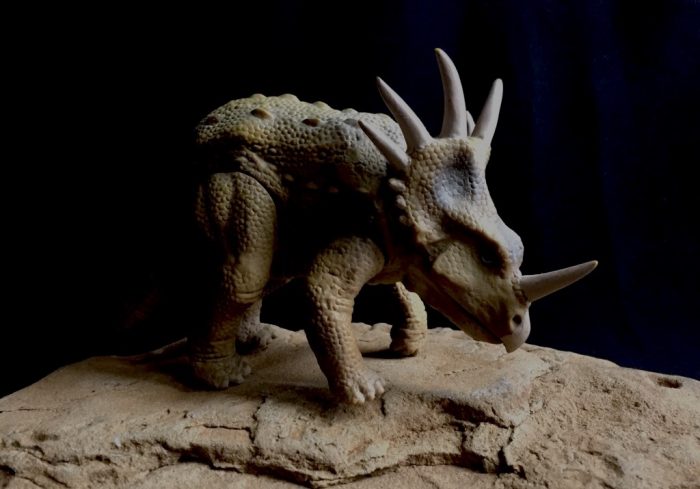
The Tsukuda Hobby Dinosaur Series was first released in the late 1980s’. The figures that made up the series included 13 species of prehistoric animal that came individually boxed and are scaled at 1:30. The Tsukuda figures share some similarities with another 80s’ line of prehistoric figures, Tyco’s Dino-Riders. Just like Dino-Riders, the eyes on the Tsukuda figures are made of small glass beads and not just sculpted or painted on. These add a different realism to the figures and give each one a unique expressive quality.
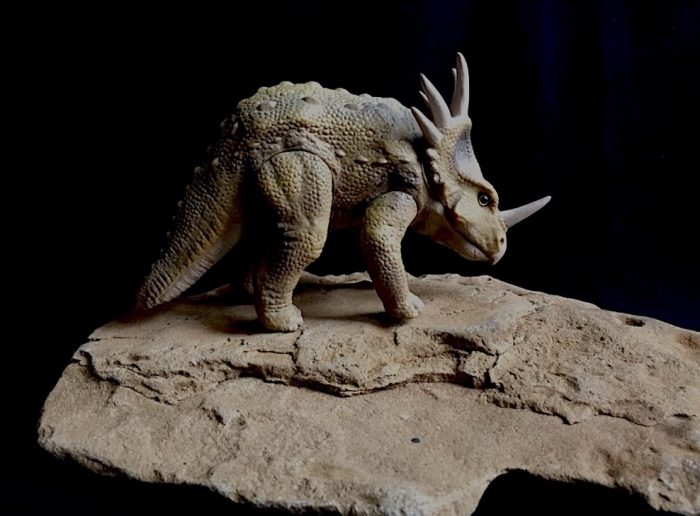
These critters included most of the famous dinosaurs, but also some species that were once popular but has now gone largely ignored. Today, we will look at one species that continues to be popular: the ceratopsian Styracosaurus. While not as famous as Triceratops, it has remained a consistent presence in each of the the succeeding lines of toy companies throughout the decades. I will skip the whole introduction about Styracosaurus‘ history since it’s a well known and much studied species.
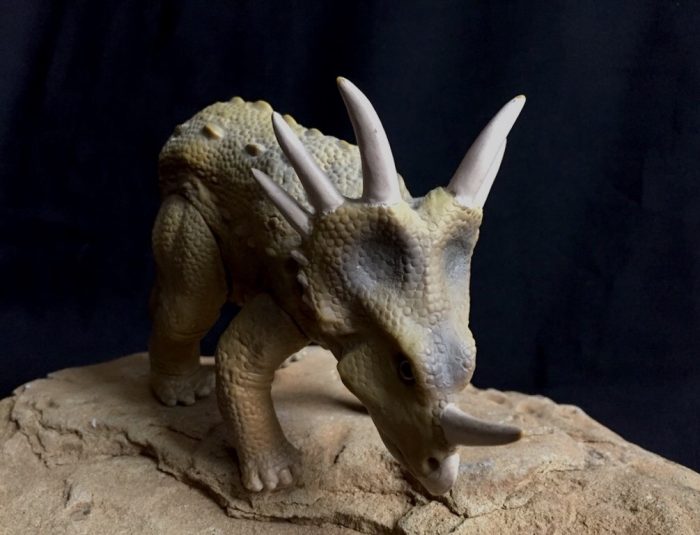
The Tsukuda Styracosaurus is a charming little figure, one of my favourites from the set. The figure is posed in a neutral stance. The articulation on the legs give you a little bit of flexibility as to how you want to pose the figure. With a little bit of adjusting of the legs, the figure can be posed as if it’s about to charge (the raised front left leg helps support this pose) or in a running pose. The back legs are much taller than the front ones, which gives the figure a hunchbacked appearance. The head, beautifully sculpted, is held lower to the ground, and if you look closely, you will notice it tilted slightly to the side. The shield spikes are coloured cream as well as the single nose horn and the beak. The shield itself is coloured plain brown, although I have seen photos of some variant showing some purple on the shield.
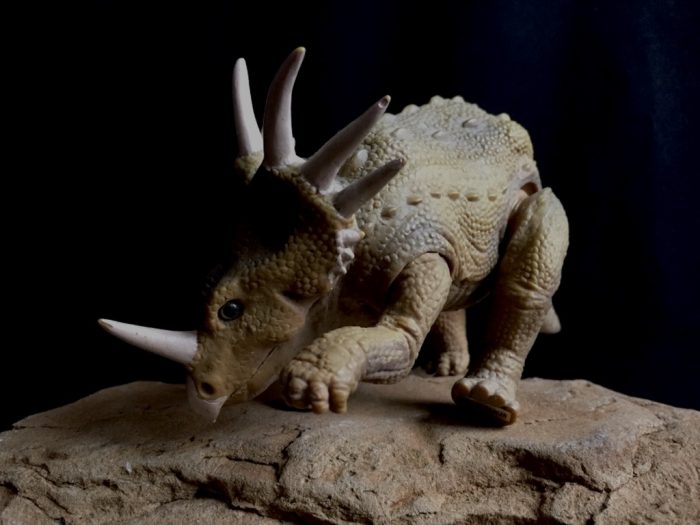
The Styracosaurus has lots of different skin texture going on all over its body. There are skin folds and bumps of varying size on the body as well as on the legs. There are prominent osteoderms on the back, arranged in five rows. Starting at the base of the neck, these osteoderms vary in size, with the largest ones being the three rows in the middle part of the back. The middle row also continues down the tail, while the others terminate just around the point where it reaches the base of the tail. The tail is hefty and is pointed directly downward. There are no curves on this one, making it look super stiff and heavy.
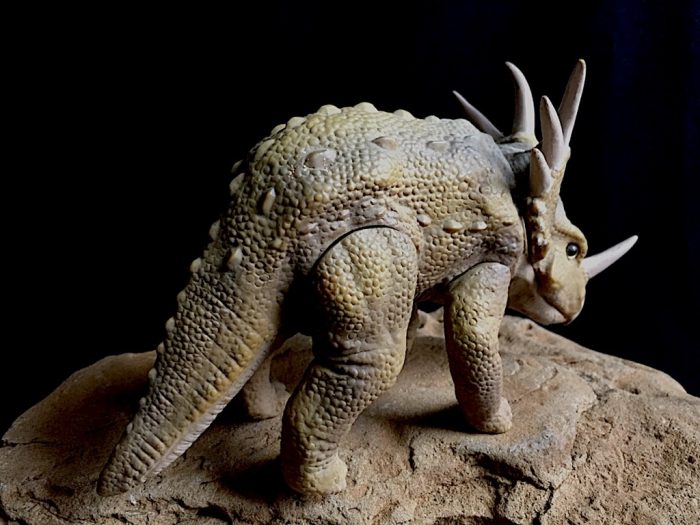
The overall colouration on my figure is a uniform brown. There is not much variation in colour, although there is a subtle shade of lighter brown here and there (most noticeable on the face and belly). Again, I have seen a variant that shows some purple on the face, as well as the body and legs.
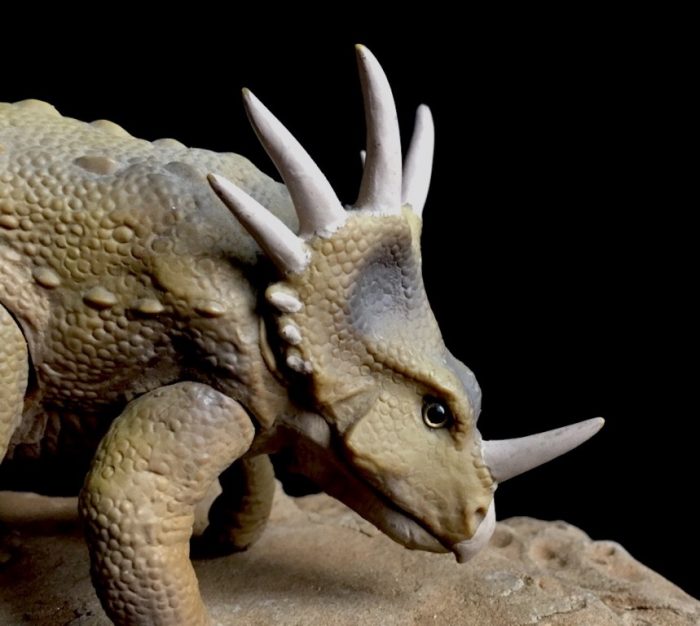
Overall, this is a nice figure that heralds back to a different, much simpler time. The simplicity of the figure is one of its great appeals, and those glass eyes add so much more life to it as it stares and follow you around. The Tsukuda Styracosaurus is not the rarest figure in the series, although it is still not easy to find. If you are lucky to have a chance to acquire it, I highly recommend getting it. It may not be the most accurate or flashy ceratopsian around, but its beady little eyes are sure to charm you and it will make a wonderful addition to your ceratopsian herd. Hope you enjoyed this review. Cheers!
Disclaimer: links to Ebay and Amazon on the DinoToyBlog are affiliate links, so we make a small commission if you use them. Thanks for supporting us!




[…] my last review, we looked at the Tsukuda Styracosaurus. Today, we will look at another classic favourite from the same line. Without a doubt, the most […]
There’s definitely a distinct charm to these older figures that is quite apart from their accuracy – I like accurate figures, too, but I appreciate the artistic qualities. I enjoyed the review, since I’m not familiar with this line but they do remind me a lot of the Tycos, which are wonderful. I’d love to see more if you have more of them!
I have mixed feeling and nostalgia for this figure.
I love the shadings in the openings of the frill. A different and a more colourful scheme on the body and on the frill could be better and the pose is quite outdated but as you had said in your review, these vintage and retro dinosaur models marked the history of dinosaurs and when those fascinating creatures were first known to science when Richard Owen invented the name ”Dinosaur” for ”Terrible lizard” in greek. The bumps and little scales running along the back is a success, the wrinkles and spikes, etc… The amount of details on this figure is impressive. Scientists think that now, dinosaurs did not drag their tails on the ground, but kept them most of the time in the air. But on this figure, the dragging tail is present, of which I am not satisfied. Overall the glossy glass eyes are very lifelike[like on the Tyco ones], as if it was staring at you and saying:” give me a hug.” LOL 😀 that is what makes it a charming figure and its retro and vintage look is keens appealing and has managed to keep it anew for many years. Great review! 😀
There is also the retired Carnegie styracosaurus, which is a gem as well.
This figure reminds me of the retro and vintage Charles Knight painting of Agathaumas and Triceratops. CERATOPSIAN DISCUSSION: Monoclonius was Edward Drinker Hope’s third described ceratopsian, after Agathaumas and Polyonax.
Other styracosaurus toys that I know are the PAPO one, the SCHLEICH one, the SIDESHOW DINOSAURIA one and finally, the CARNAGE RESAURUS one. I did not know the Tsukuda Hobby Collection one. Which one among those Styracosaurus toys is your favourite? Let me know. There is also the brand new 2017 to be released CollectA styracosaurus.
This figure looks a little bit like the Tyco Centrosaurus.